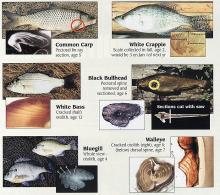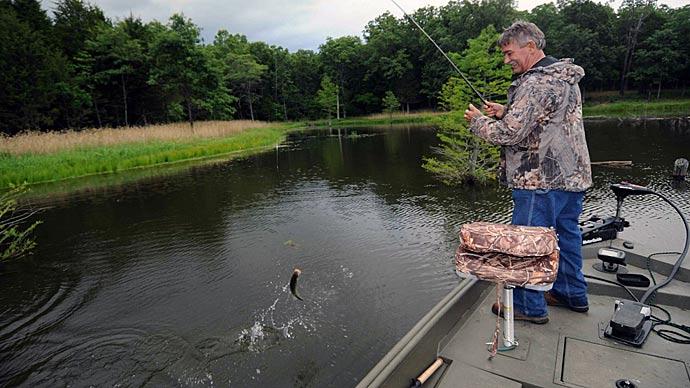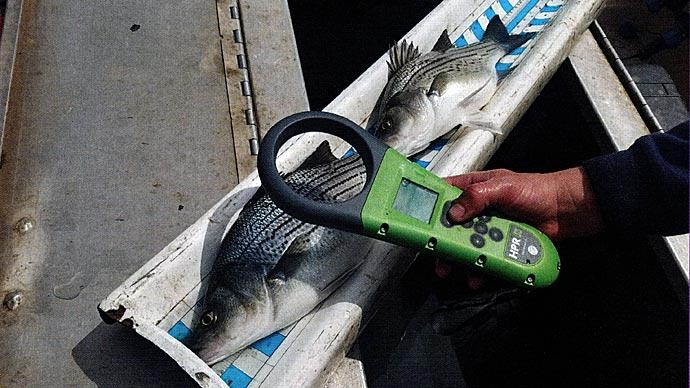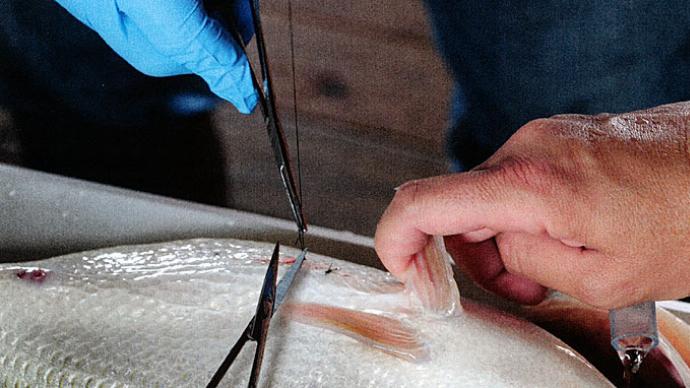With increasing interest in ponds across this country, more pond owners and managers are seeking detailed information about "how to" or "hands on" pond management practices. This is most evident from the nature of the questions sent to Pond Boss Magazine and asked on the Pond Boss Forum. A critical question often at the core of most pondmeister's thoughts is "How are my fish doing?" To answer this question, pondmeisters, with their ever-increasing knowledge and sophistication, began to use the relative weight concept to help provide an answer. However, relative weights provide part of the answer. Professional fishery biologists would prefer to have information on fish age and growth to truly understand a Population.
Perhaps you read the article titled Trade-Offs in Lake Management in the January/February issue of Pond Boss and looked at the charts regarding the status of a small Missouri impoundment. Largemouth bass and bluegill growth were critical components of that assessment.
In the big picture of determining "How are my fish doing?" age and growth information together provide a combined assessment that actually indicative of other factors such as water quality, prey base, habitat suitability, and genetics. All these factors are reflected in the quality of your fish community.
So, let's look into some of the aging structures commonly used for fish. Then, we'll come back to how you can use this information.
Common Fish Aging Structures
Biologists can estimate the age of individual fishes using a variety of aging structures. For years, many fishes have been aged from their scales. Perhaps you have heard the analogy that scales have annual rings much like a tree'! The concept is that fish lay down an annual mark during periods of slow growth during winter. It's quite distinct from the warm part of the year when fish accomplish most of their growth.
Biologists actually remove scales from different locations on different types of fishes. For some of the spiny-rayed fishes such as largemouth bass and bluegill, scales often are taken from the tip of the pectoral fin, and just below the lateral line. Look at the bluegill picture that accompanies this article. The fin on the side of the fish that originates just behind the gill flap is called the pectoral fin. Scales are sometimes aged simply by placing between two glass slides and viewing under a microscope. However, as fish get older the scales tend to become thicker and more opaque. Such scales can be pressed into acetate (i.e., plastic) slides, which greatly improves viewing.
Scales are not always a reliable aging structure. The picture of the white crappie scale that accompanies this article shows a scale at its best. Others can be much more difficult to interpret, with extra marks and lines on the scale. Biologists in the southern part of the country are to the point where few actually use scales to age fish. The shorter, warmer winter makes the annual marks less distinct than in the northern states. Even in the north country, ages of older fish are unreliable from scales. Generally, we can age fish from scales over their few years of life. However, a 15-year-old walleye scale would typically be under-aged by 5 years or more.
Today, many fishery biologists rely more on otoliths than scales for fish aging. The age estimates from otoliths tend to be much more reliable, even for older fish. Otoliths are also known as "earstones," and they are part of the inner ear of a fish. They are part of the balance and hearing systems for fish.
For some fishes, especially at younger ages, we often can age the otoliths whole. For example, in our recent work with walleye and bluegill otoliths, we generally used whole otoliths through about age 4 or 5. If you look at the bluegill otolith that accompanies this article, the annual marks (laid down during winter) are distinct even in the whole otolith. The picture was taken under low magnification with a microscope. For older fishes, we often crack the otoliths in half, sand them a little, and then age them. Most often, we'll put them in a small base of play-dough, and put a drop of oil on the otolith to make it easier to see the annual marks. Then, we use a small, fiber-optic light held just to the side and below the otolith. Once you get the technique down, the annual marks almost jump out at you. Until then, it can be a little frustrating.
Many other structures have been used to age fish. Fin rays are used for some fish. We included a picture of a dorsal spine aged for a walleye. This structure has to be sectioned with a fine, diamond-edged waver blade on a special saw.
Some marine fish are aged by sectioning their vertebrae. Soft fin rays can be aged for fishes such as suckers and other species. In the paddlefish, which is a cartilaginous fish rather than a bony fish, we can age thin sections (slices) taken from the bottom jaw of the fish. In a current study with common carp, we first aged them with otoliths, which of course requires that we kill the fish. However, the hard, spiny, serrated pectoral fin rays turned out to be reliable through age 13. Thus, biologists can at times find nonlethal alternative aging structures. For years, catfish were aged by sectioning their spines, just as you can see for the bullhead spine section with this article. Recent work within the profession indicates that otoliths may be a more reliable aging structure than spines for many catfish species.
It's important that we stress one thought. Aging fishes from these various structures can at times be very easy, but many times is difficult. The most useful aging structure will vary by geographic location, by fish species, and at times even from lake to lake. Generally, a little help getting started, followed by some practice, makes a big difference.
How To Use This Information
Why age fishes? Well, this information is used to determine maturity, growth rates, survival or mortality rates, and longevity. In addition, this information can provide biologists with information on year-class strength of a fish population. Fish are "assigned" a birthday by biologists. In the northern hemisphere, it's January 1 each year. Actually, it's not really a birthday for most fish, other than guppies and mosquitofish. It's really a hatch-day, as most fishes are hatched rather than born. However, you probably catch our point. As a result of these age assignments, we can then tell in which year a fish was hatched. A fish hatched in 2005 then becomes age 1 on January 1 of 2006. This is the source of the term "year class," which refers to the year in which a fish was hatched. The 2001 year classes of walleye, bluegill, yellow perch, and white bass were all quite strong in eastern South Dakota. Weather conditions were good that year.
One of the important jobs of a fishery biologist, either an agency biologist or a private consultant, is to know the growth characteristics of fish at their geographic location. They either know typical growth rates for their location, or they know were to find such information. Most state agencies have growth summaries showing averages and ranges for sport fish in their state.
So, let's take this back to your pond. Whether electrofishing is used to sample a fish community, or a pondmeister monitors angler catches, trends over time are an important source of information. Trends in abundance, fish sizes, and growth tell the final story on what is happening within a pond fish community. If all is well - then hands off. However, if management strategies are implemented to make a change, then changes should be evident in abundance, size, condition and growth information. If largemouth bass are too dense, a culling program might be instituted. If so, and sufficient small bass are culled, then abundance (catch rates) should decline, and size, growth, and condition should increase. In reality, growth information is more difficult and time-consuming to obtain than other population information. However, its value is correspondingly higher as well!
Dr. David W. Willis is a professor in the Department of Wildlife and Fisheries Sciences, South Dakota State University in Brookings.
Reprinted with permission from Pond Boss Magazine




